The best of the best: Ranking the 12 winningest teams in MLB history

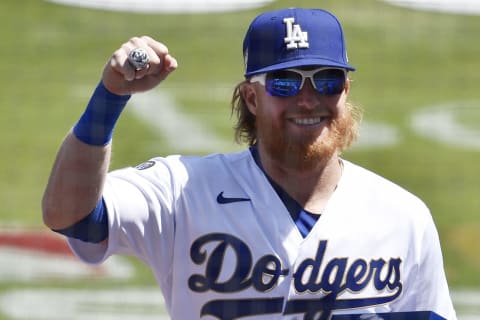
Major League Baseball has its own version of the popular 700 Club. It consists of teams that have compiled a winning percentage of .700 or higher over the course of a full season of at least 130 games.
But the MLB version is a lot more exclusive than the better-known one on TV.
In fact, in MLB history, there are only a dozen members of the .700 Club, only two of which have been admitted in the past half-century.
In a league as competitive as MLB, a .700 winning percentage is a monumental goal. The most recent team to do so was the 2020 Los Angeles Dodgers, whose 43-17 record equated to a .717 winning percentage. The Dodgers, of course, went on to win the World Series in six games over the Tampa Bay Rays.
But for purposes of enrollment in the .700 Club, the 2020 Dodgers had the distinct COVID-induced advantage of only having to play 60 games. That’s 102 fewer than are normally scheduled by a modern MLB club.
Not that carrying a .700 winning percentage is easy at any point, but in the last six seasons alone three teams hit the 60-game mark rolling along at that pace. In addition to the 2020 Dodgers, the 2016 Cubs and 2017 Astros were both 42-18, .700, after 60 games. Like the Dodgers, both, of course, went on to win the World Series, although with percentages that dipped to .640 for the Cubs and .623 for Houston.
Those are very, very lofty … but they are not .700.
In the game’s early days, when what we would now consider short seasons were the norm, .700 winning percentages were relatively common. In fact, 18 times prior to lengthening of the schedule to 132 games in the mid 1880s, a team finished what was recognized as a Major League season with at least a .700 winning percentage.
The all-time record in that department is held by a club known as the Boston Red Stockings, who in the 1875 National Association – a precursor to today’s National League – won 71 of their 79 games. That’s an .899 percentage.
The 1884 St. Louis Maroons of the Union Association and 1872 Boston Red Stockings of the National Association also topped .800 in seasons of 113 and 47 games, respectively.
Not that winning 70 percent of a team’s games guarantees it anything in the way of postseason success. In fact baseball’s most successful teams — as measured by their performance over the course of a full season of at least 130 games — have distinctly underachieved in their post-seasons.
Of the 12 qualifying teams with percentages of .700 or higher, only five went on to win the World Series. Of the remaining seven, five lost their World Series (or, in the case of one, their 19th Century version of that event), one was eliminated prior to reaching the Series, and one compiled its .700 record in a season in which there was no postseason.
Here’s a look at the dozen teams that qualified for membership in baseball’s most exclusive club, the .700 Club.
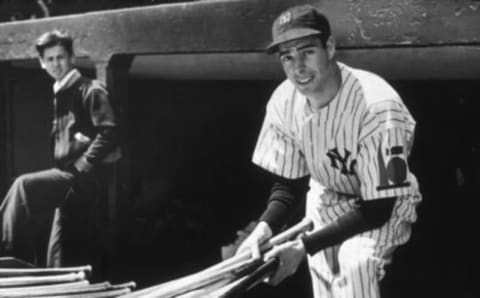
1939 New York Yankees, 106-45, .702
.700 Club rank: 12
This is the first of three New York Yankees teams on this MLB history list, all of them eventual World Series winners.
The 1939 team may be best known for its star who did not finish the season. Lou Gehrig, captain and long-time first baseman, left the lineup in May shortly before being diagnosed with the disease that would take his life two years later.
So it is a bit ironic that the Yanks were as good as they were in a season they got so little production out of Gehrig. They didn’t need him. Joe DiMaggio batted .381, four other regulars joined him above .300, and the Yanks averaged 6.4 runs per game, a half-run more than any of their competitors.
An astonishing 31 times during 1939 the Yankees scored in double figures. The Philadelphia Athletics could tell you all about New York’s offense. In a June 28 doubleheader at Shibe Park, the Yanks beat up the visiting A’s 23-2 and 10-0, scoring in nine of their 18 at-bats.
For the season, the average score of a Yanks-A’s game was 8-3.
New York could pitch as well as hit. The Yanks also led the AL in fewest runs allowed, giving up just 3.7 in a season when teams averaged 5.2 runs every nine innings. Red Ruffing was a 21-game winner, but seven Yankees pitchers won in double figures.
Amazingly, that means the Yankees’ Pythagorean record in 1939 — what they should have done based on their production — was 111-43, a .721 percentage that is five games better than how they actually played.
As dominant as the Yankees were, they were also actually unlucky.
That year’s World Series was no contest, the Yanks sweeping the National League champion Cincinnati Reds while outscoring them 20-8. Of the 36 innings played in that World Series, the Reds led for just four.
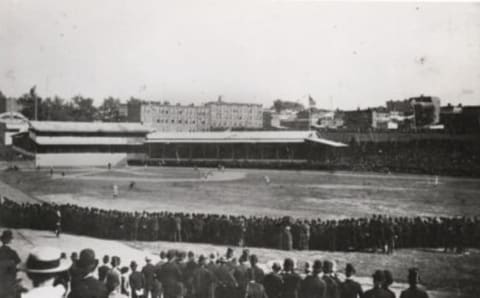
1887 St. Louis Browns, 95-40, .704
.700 Club rank: T-10
The Browns dominated the American Association (AA), a major league during the 1880s. It was the third of four successive pennants for the Browns, and statistically the best of those four teams.
St. Louis led the AA in both runs scored (8.3 per game) and runs allowed (5.6 per game), creating a stunning differential of 2.7 runs per game.
You couldn’t beat the Browns in St. Louis, where they were 58-15. Between April 24 and May 26, they played 26 games on their home field, winning 24 of them.
Most of the Browns players are anonymous today, but they were famous in their time. Outfielder Tip O’Neill piled up 235 base hits in 517 official at-bats, a .435 batting average. First baseman Charles Comiskey, later to be a famous team owner, hit .335 and three other Browns also surpassed .300.
The pitching was divided among three stars. Silver King made 44 starts and worked 390 innings, running up a 32-12 record with a 3.78 ERA. Bob Caruthers, who split his time between the mound and outfield, was 29-9 with a 3.30 ERA in 39 starts and 341 innings.
In fact, Caruthers was an 1880s version of Shohei Ohtani, a true two-way threat. In 364 official at-bats, he batted .357.
The third ace, Dave Foutz, got in 339 innings, enough to run up a 25-12 record and 3.87 ERA.
That season’s World Series was played across a panoply of 15 games spanning more than two weeks and nine different cities. But the Browns, victors over Chicago’s National League champions one year earlier, succumbed 10 games to five to the 1887 NL champion Detroit Wolverines.
O’Neill managed just a .200 batting average.
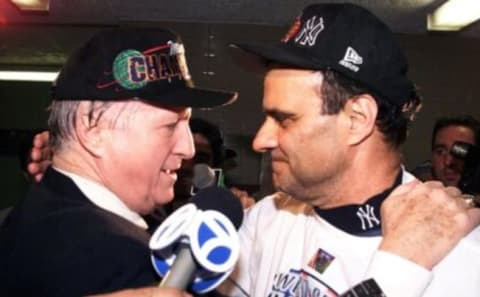
1998 New York Yankees, 114-48, .704
.700 Club rank: T-10
When baseball fans younger than 50 years old think of the great teams they have seen, the 1998 Yankees likely leap right to the front of the list.
Losing four of their first five games for manage Joe Torre, the Yanks did not reach first place until the final day of April. But once they got there, the AL East race was effectively over. From April 29 on, New York won 99 of its final 131 games, a .756 winning pace.
They opened up a double-digit division lead in early June, and formally clinched the division with a 7-5 victory over Boston on Sept. 9.
The Yankees averaged 5.96 runs per game while allowing just 4.05, both of those figures leading the American League. Every member of the starting lineup (plus reserve Shane Spencer) reached double figures in home runs, with Tino Martinez driving in 123 and Paul O’Neill 116.
The Yanks had a team OPS of .825.
On the mound, David Cone was 20-7 while Orlando Hernandez presented a 3.13 ERA and Mariano Rivera ran up 36 saves.
The postseason was a romp as expected. The Yanks polished off the Texas Rangers in three straight division series games, eliminated the Cleveland Indians in six games to win the ALCS, then swept the San Diego Padres in the World Series.
The National League champs never had a chance: New York outscored San Diego 26-13 and trailed for only three innings the entire series. New York’s infield tortured Padre pitchers. Catcher Jorge Posada batted .333, Martinez hit .385, second baseman Chuck Knoblach batted .375, and shortstop Derek Jeter hit .353.
It was the first of three straight World Series wins for the Yanks, making them the only team since the 1970s to claim the title thrice in succession.
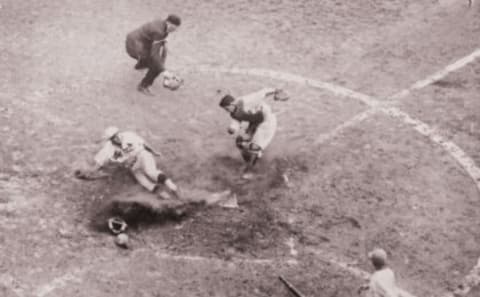
1931 Philadelphia Athletics, 107-45, .704
.700 Club rank: T-8
This was Connie Mack’s last great team, and arguably the best of his half-century career as the team’s manager.
It featured four legendary Hall of Famers at the peaks of their game. Catcher Mickey Cochrane batted .349, first baseman Jimmie Foxx hit .291 with 30 home runs, left fielder Al Simmons hit .390, and mound ace Lefty Grove was 31-4.
Grove produced one of the great pitching seasons of all time. In a season when the league average ERA was 4.38, Grove turned in a 2.06 ERA. And he did so while making 30 starts, 11 relief appearances, and turning in 289 innings.
In the early 1930s, nobody had thought up the concept of ERA+, a new statistic that contextualizes a pitcher’s performance against that of his peers. Grove’s ERA+ was 217, meaning he was more than twice as dominant as his average competitor.
In 1931 Grove led he league in wins, ERA, complete games (27), shutouts (4), and strikeouts (175).
The A’s secret was an overwhelming dominance of the league’s weak sisters. Against Boston, Detroit and Chicago — the sixth- through eighth-place teams— Philadelphia compiled a record of 53-11, outscoring those three teams 410-225.
Coming off 1929 and 1930 World Series wins, the A’s built a double-digit lead by July 23 and coasted home 13.5 games ahead of the runner-up Yankees.
But like other dominant teams, they failed in the World Series. The NL champion St. Louis Cardinals, losers to the A’s in five games in 1930, got revenge, winning a seven-game series. That was a series in which Cardinal star Pepper Martin batted .500 and stole five bases.
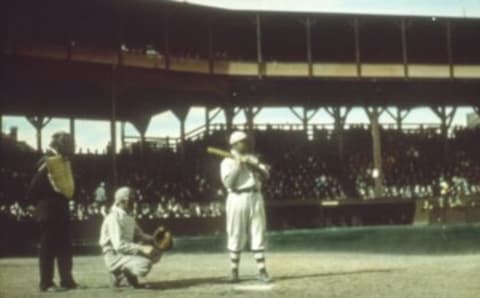
1907 Chicago Cubs, 107-45, .704
.700 Club rank: T-8
Two “teams” can be thought of as being on this list twice because they reached a .700 percentage in two seasons with substantially the same cast. The 1907 Cubs are the first of those two.
This 1907 club was substantially identical to the 1906 Cubs (who we’ll discuss shortly), with the major difference being that the 1907 version actually won its World Series. The Cubs polished off the Detroit Tigers in what amounted to a five-game sweep, the first game was called a tie due to darkness.
Cubs pitchers limited the Tigers to just three runs in the four games played to a decision, the Tigers batting just .215 for the series. Detroit star Ty Cobb managed just four hits in 20 at-bats, a .200 average. In that series, Cobb came to bat 11 times with 23 runners on base and failed to drive any of them in.
The regular season was a cakewalk. Chicago led the NL in both runs scored (3.7 per game) and runs allowed (2.5 per game), winning 54 times at home and 53 on the road.
Never more than one game out of the lead, the Cubs seized first place for good in late May. They ran off seven separate streaks of six wins or more.
The roster included four future Hall of Famers, among them the double play combination of shortstop Joe Tinker, second baseman John Evers, and first baseman-manager Frank Chance.
The fourth future immortal, pitcher Mordecai “Three-Finger” Brown, was 20-6 with a 1.39 ERA in 233 innings.
But the true ace in 1907 was Orval Overall, who went 23-7 with a 1.68 ERA in 30 starts encompassing 268 innings.

1897 Boston Beaneaters, 93-39, .705
.700 Club rank: 7
The 1897 Beaneaters won perhaps the most heated pennant race in baseball history. They finished just two games ahead of the three-time defending champion Baltimore Orioles after defeating the Orioles in a three-game final week showdown series in Baltimore. That left the Orioles at 90-40, .692, the best record ever compiled by a team that did not finish first in the regular season.
This was a great Boston team, a five-time champion in the 1890s. The Beaneaters also won in 1891, 1892, 1893, and 1898. The club was led to all five pennants by Hall of Fame manager Frank Selee.
The roster included four future Hall of Famers. Third baseman Jimmy Collins was considered the best-ever at his position long after he retired. Hugh Duffy batted .340 that season and .326 for his career. Outfielder Billy Hamilton, the game’s greatest base-stealer prior to the arrival of Lou Brock, stole 66 of his career 914 bases in 1897.
The pitching staff was led by Kid Nichols, a future 300-game winner who was 31-1 with a 2.64 ERA in 368 innings of work.
In the one-league 1890s, there was no World Series, but the first- and second-place teams met in a postseason competition called the Temple Cup.
In 1897, that threw the Beaneaters back against the rival Orioles. However, coming off the pulsating finish to the regular season, Boston played listlessly in October, losing to the regular season runners-up in five games.
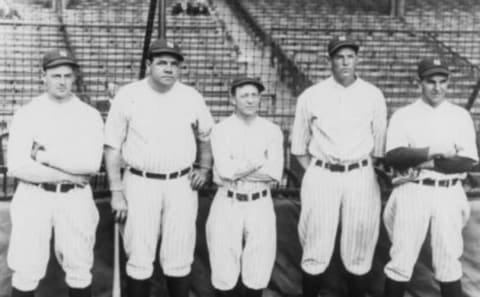
1927 New York Yankees, 110-44, .714
.700 club rank: 6
Any time the all-time great teams are considered, the 1927 Yanks are sure to be in the mix … and with good reason.
This is the ballclub that featured both Babe Ruth and Lou Gehrig in their absolute primes.
Ruth batted .356 with 60 home runs and 165 RBI that year, yet lost the Most Valuable Player vote to Gehrig, who hit. 373 with 47 home runs and 173 RBI.
The Yanks averaged 6.3 runs per game, while the pitching staff allowed just 3.9. In that fall’s World Series, the Yankees supposedly intimidated the NL champion Pittsburgh Pirates with their display of might during pregame batting practice.
That may or may not be true, but this is: New York outscored Pittsburgh 23-10 in that World Series, and outhit the Pirates .279-.223.
Winning their first six decisions, the Yankees never spent as much as a day out of first place, and won the AL pennant by 19 games. Like the 1939 Yanks, they could pile up big numbers. The 1927 team managed double-figure run production 26 times, and were shut out only once. That was by Lefty Grove, 1-0, on September 3.
Waite Hoyt, 22-7, led a staff of six double-digit winners. Four Yankees – Ruth, Gehrig, left fielder Bob Meusel, and second baseman Tony Lazzeri – drove in at least 100 runs.
The team batting average was an intimidating .307.
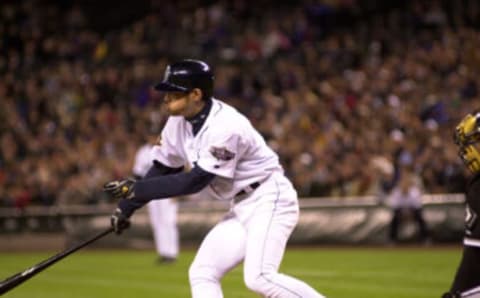
2001 Seattle Mariners, 116-46, .716
.700 Club rank: 5
The 2001 Seattle Mariners are poster children for challenges presented by the modern multi-layered postseason.
Statistically, there is no doubt that the Mariners were the best team in 2001. They led the majors in runs per game (5.72), RBI (881), stolen bases (174), on base percentage (.360), runs allowed per game (3.87), ERA (3.54), shutouts pitched (14), and fewest hits allowed (1,293).
Ichiro Suzuki, their rookie import from Japan, won the batting title at .350 with league-leading totals in hits (242) and steals (56). For that he became only the second player — after Fred Lynn in 1975 — to be named both Rookie of the Year and Most Valuable Player.
But the Mariners were no one-man band. First baseman John Olerud, second baseman Bret Boone, and designated hitter Edgar Martinez all topped .300, Boone hit 37 home runs and drove in 141 runs.
The pitching staff featured five double-digit winners led by Jamie Moyer (20-6). Kaz Sasaki saved 45 games.
Like the 1927 Yankees, the 2001 Mariners never spent a minute out of first place. They won nine straight in late April, eight straight in mid-May, and 15 straight in late May and early June.
A full 20 games ahead on June 30, they set out on a course to challenge the all-time record for single season victories of 116. Playing .714 baseball after July 31, they got it with their 116th win on October 6 with a 1-0 shutout of Texas. They missed a chance to set a new record on the season’s final day, losing 4-3.
The Mariners won a tough five-game division series against Cleveland, but lost the ALCS in five games to the three-time defending World Series winning Yankees.
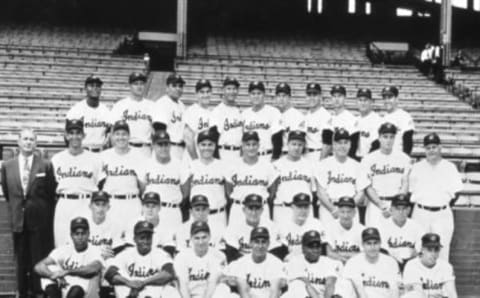
1954 Cleveland Indians, 111-43, .721
.700 Club rank: 4
In the dozen seasons between 1947 and 1958, only two teams were able to finish ahead of the New York Yankees. The Cleveland Indians did it both times.
The Indians won the 1948 World Series, then, in 1954, put together one of the greatest runs in American League history. Their 111 victories was the most until the 1998 Yankees (playing eight more games) won three more. Their .721 winning percentage remains to this day a league record.
Amazingly, they were able to put down the Yankees by a full eight games despite the fact that the Yanks won 103 games a team-high between 1942 and 1961.
The secret was a superb pitching staff that allowed only 3.23 runs per game, a Major League low. Cleveland’s 2.78 ERA was more than a full point below the 3.90 MLB average for the season.
That staff was led by a trio of Hall of Famers. Early Wynn went 23-11 with a 2.73 ERA in 271 innings, Bob Lemon was 23-7 with a 2.72 ERA in 258 innings, and veteran Bob Feller was still good for a 13-3 record and 3.09 ERA. A fourth Hall of Famer, Hal Newhouser, though past his prime, was 7-2.
Reigning MVP Al Rosen led the offense with a .300 average and 102 RBI. Another Hall of Famer, Larry Doby, hit 32 homers and drove in a team-high 126 runs. Leadoff man Bobby Avila had a .402 on base average.
In that October’s World Series, though, the Indians failed to win even a single game. The NL champion New York Giants beat them 5-2 in the first game on Dusty Rhodes’ pinch-hit 10th-inning three-run home run, and followed that with three more victories.
In the intervening nearly seven decades, the Indians have only been back to the World Series three times, two of those ending in excruciating heartache. They lost to Atlanta in six games in 1995, lost to Florida in an 11-inning seventh game in 1997, and fell to the Cubs in a 10-inning seventh game in 2016.
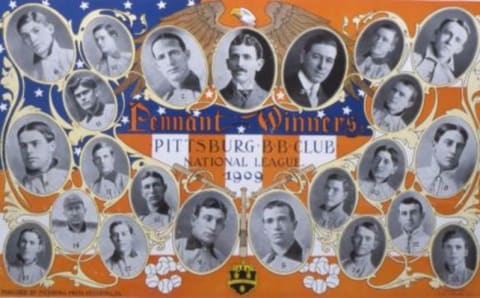
1909 Pittsburgh Pirates, 110-42, .724
.700 Club rank: 3
The Pirates of the first decade of the 20th Century are doubtless the best team nobody remembers today.
The 1909 club, the fourth Pirate champion of that decade, won a sensational pennant race over the three-time defending champion Cubs, who won 104 games. But that wasn’t enough to overcome Pittsburgh’s deep pitching plus Honus Wagner.
At 4.5 runs per game, Pittsburgh led the majors in offense in 1909. The Pirates also led the National League in defense, allowing just 2.9 runs per game.
Wagner, although well into his 30s, remained the linchpin. He batted .339 to win his seventh of an eventual eight batting titles, also leading the league in doubles (39), triples (19), stolen bases (53), RBIs (100), on base average (.420), slugging (.489), and – naturally – OPS (.909).
His mid-order cohort and fellow future Hall of Famer, player-manager Fred Clarke hit. 287.
Top to bottom, the Pirates ran teams wild. Seven of eight regulars stole at least 10 bases, led by Wagner and Clarke (31).
But it was the pitching staff that gave Pittsburgh its edge. Howie Camnitz won 25 games, Vic Willie won 22, and Lefty Leifeld added 19, all three with ERAs below 2.50. That was nothing unusual in Pittsburgh, where the staff ERA was 2.07.
The Pirates and Detroit tigers fought evenly through six World Series games before Pittsburgh blew open the deciding seventh game. With rookie Babe Adams allowing just six hits and holding ty Cobb hitless, Pittsburgh won 8-0 to claim the city’s first World Series victory.
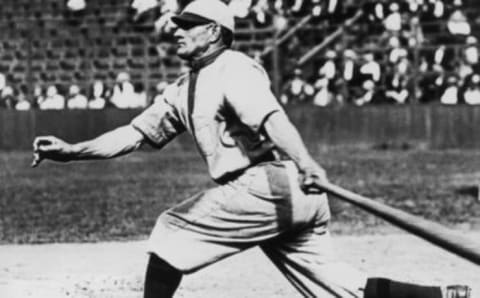
1902 Pittsburg Pirates, 103-36, .741
.700 Club rank: 2
As good as the 1909 Pirates were, the 1902 team may have been better. Back in the days when the city still spelled its name without an “h” on the end, the Pirates swept through the National League season, winning by a record 27 and one-half games.
More than a century later, that remains the record for largest margin of victory.
Also managed by Clarke and led by Wagner, that Pirates team made a mockery of the National League race. Assuming first place for good 10 days into the season, Pittsburg built a double-digit lead by mid-June.
The Pirates won 10 straight in early May, reeled off another eight straight in early July, and won a final eight straight in late September, by which time the pennant had long since been decided.
In fact the Pirates clinched the pennant when they beat Brooklyn 5-3 on September 2, more than a month before the season’s scheduled end.
Nobody gave the Pirates any trouble. They rolled up winning percentages of .650 or better against all seven of their National League competitors, their most defeats — seven in 20 games — coming at the hands of Chicago.
Almost unbeatable in Pittsburg, where they were 56-15 nearly outscoring opponents two-to-one, they were almost as good on the road. The Pirates won 46 of their 67 road games, outscoring their hosts by a cumulative 365-233.
Wagner batted .330, but teammate Ginger Beaumont won the batting title at .357. Clarke hit .316.
Jack Chesbro, a Hall of Fame right-hander, won 28 times against just six defeats with a 2.17 ERA in 286 innings. Deacon Phillippe and Jesse Tannehill also won 20 games.
Unfortunately, this great team did not get a chance to prove itself in a World Series as that event would not be established for one more season.

1906 Chicago Cubs, 116-36-2, .763
.700 Club rank: 1
Statistically, the 1906 Cubs were superior to their 1907 successors. This Cubs team led the majors in both runs scored (4.6 per game) and runs allowed (2.5 per game),
Chance led the offense with a .319 average, ably assisted by catcher John Kling (.312) and third baseman Harry Steinfeldt (.327). Chance also drove in a team-high 83 runs.
That may not sound like many, but the Cubs pitching staff didn’t need much help. Mordecai Brown was 26-6 with a 1.04 ERA; he lost only twice after July 1. Jack Pfeister was 20-8 with a 1.51 ERA, and Ed Reulbach was 19-4 with a 1.65 ERA.
That gave the Cubs’ Big Three a cumulative 65-18 record and 1.38 ERA in 745 innings.
The Cubs started slowly — at least by their standards — and did not lock into first place until the second week of May. But they finished in a whirlwind, running up records of 25-3 in August and 21-5 in September after the issue had been settled. They played .831 ball across the second half of the 154-game schedule.
Next. 30 MLB records that will never be broken. dark
The only way to explain their six-game loss to the inferior AL champion White Sox is to acknowledge that baseball is a funny game. White Sox pitchers allowed Cubs hitters just eight runs in the six games, stranding 37 Cubs baserunners.